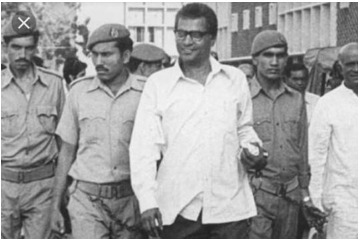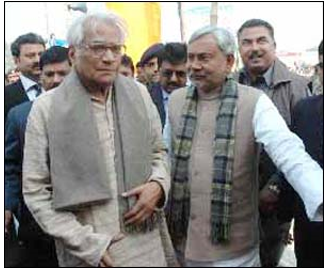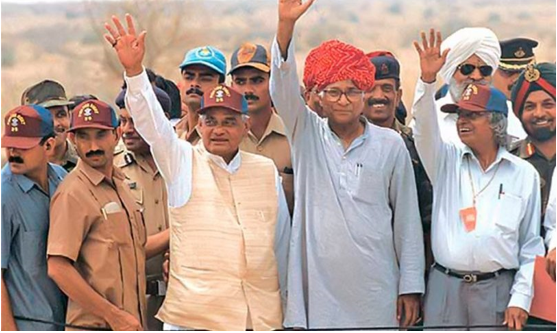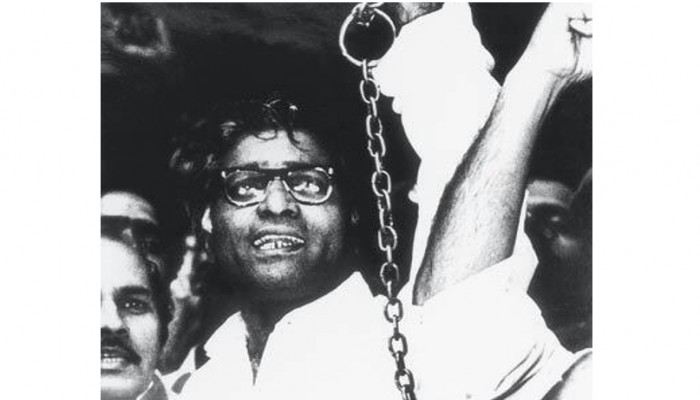The Life and Times of George Fernandes - The man who always took on the 'Establishment'
- In Politics
- 08:35 PM, Jan 29, 2019
- Shwetank Bhushan
An era comes to an end as George Saab passes away. I feel terribly sad about the demise of one of the most iconic political leaders in India, the man who took on the mighty and the powerful, and whose courage & integrity will continue to inspire.
This piece is a tribute to George Saab as I believe that his stories must be told so that the new generation understands what the fight for establishing democracy really means.
Born in Mangalore, to an insurance executive, George Fernandes was sent for training as a Roman Catholic priest when he was just 16. Frustrated with what he saw as double standards and hypocrisy in the Church, he left the seminary. He was a rebel right from his teen years.
"I was disillusioned because there was a lot of difference between precept and practice where the Church was concerned"- George Fernandes.
At the age of 19 itself, George began to organize workers in the road transport, as well as hotels in Mangalore. Moving to Bombay in 1949, George led a hard life, sleeping on pavements, until he got a job with a newspaper as a proofreader.
Inspired by Ram Manohar Lohia, Fernandes joined the socialist trade union movement during the 50s and 60s and made a name for himself in Mumbai's trade unions, served prison terms fighting on behalf of workers.
But it was the 1967 general elections that brought him into the limelight, in which the Samyukta Socialist Party offered him a party ticket for the Bombay South constituency against the formidable S. K. Patil, a seasoned politician. To everyone’s surprise, George won! This win earned him the title of “George the Giant-killer.”
The next triumph of George Saab came just seven years later. As the President of the All India Railwaymen's Federation, he organized the All India Railway strike of 1974, against the pay and working conditions that paralyzed the Indian Railways, the arteries of the nation. Shutting them down would shut down the whole nation. And that is what it did.

He was arrested and the picture here is of him being led away from a railway station after his arrest that made him a man to be reckoned with.
Before the emergence of Bala Saheb Thackrey, it was only George Saab who could, and had organized several Bombay Bandhs and succeeded in shutting down Bombay.
In fact, it is said, that the Railway Strike of 1974, was also one of the factors that prompted Indira Gandhi to declare Emergency. She also helped Shiv Sena as a counter to the Trade Unionists.
A year later Prime Minister Indira Gandhi declared a state of emergency. The nation was outraged.
George chose to oppose the emergency in his own way, violently. The Baroda Dynamite case was hatched between Fernandes, Kirit Bhatt, President of Baroda Journalists Union and Vikram Rao, a TOI staffer. The plan basically was to blow up the dais, at Varanasi, 4 hours before Indira Gandhi was to address a meeting there.
An arrest warrant was issued against George Fernandes also but he went underground to avoid arrest. Ultimately he was arrested on June 10, 1976, at Kolkata.
The iconic image (the header image) of George Fernandes being arrested during Emergency will always stay in our minds and continue to inspire us, how he was prepared to put his life for liberty and democracy of the country.
By now George Saab, a fluent orator who could easily speak ten languages fluently, was no longer just a Bombay leader. He had become a well-known figure nationwide.
George Saab was not from Bihar, nor had he ever been to Muzaffarpur earlier. But in the 1977 general elections, he won from Muzaffarpur Lok Sabha seat by a huge margin of 3 lakh votes while still in prison.
He worked as Industries Minister in Janata Govt. During that period he is more remembered for his clash with Coke and IBM over FERA violations. Though the Janata Government fell, and in 1980, Indira Gandhi - whom Fernandes once called a "congenital liar" returned back to power.
But George Fernandes managed to retain his seat in Muzaffarpur, and again won twice from Muzaffarpur in 1989 and 1991.
Post the 1980s, George Fernandes gave the fight against injustice greater priority than acquiring power, despite having personally suffered the excesses of the Emergency. He fought his way out of an almost isolated political existence by leading the battle against the Rajiv Gandhi government’s reported corruption in the Bofors and HDW submarine deals.
In late 1989, Prime Minister VP Singh appointed George Saab as the Railway Minister – ironically the same man had led the biggest railway strike in Asia and headed railway unions.
For three days he refused to go to Rail Bhavan wondering how could he be sitting across them at the table now. VP Singh assured him he would change his portfolio after three months, which never happened.
As Minister of Railways, George Saab was one of the driving forces behind the Konkan Railway and set up the Konkan Railway Corporation in 1990, as Sreedharan as it’s first CMD. He also initiated work on the Delhi Metro project.

In 1995, when Samata Party convincingly lost the legislative elections in Bihar, Nitish Kumar almost begged his mentor George Fernandes to forge an alliance with the BJP- who was viewed as untouchable by many regional parties- during the 1996 general elections. Fernandes and senior BJP leaders Atal Bihari Vajpayee and L.K. Advani began to interact at the political level, resulting in ties between the former socialists and the BJP.
In 1998, Mr. Vajpayee felt George Fernandes was the best bet to help him achieve his alliance. The NDA government chose George Fernandes as the convener of the alliance as he was considered by the BJP to have given it the legitimacy required to reassure all the dithering "secular" allies to come on board to give it a clear majority.
As the convener, George Fernandes was the Sankat Mochan of Vajpayee's government as he did not believe that the words “Hindu” or “Nationalist” needed to be treated like abuse as if being either was a crime. He was always ready to do this as he was determined not to be the cause of a non-Congress government falling this time, no matter what he or his colleagues lost as a result.
He served as Defense Minister in the NDA Government, from 1998-2004. History will never forget these three men - Kalam, Fernandes and Vajpayee - the men behind Pokhran II.

As the Defense Minister, George Fernandes was the one who first called out China as India's main enemy, was then ridiculed for it.
Many in the Army, still rate him as one of the best Defense Ministers. He was pretty much a hands-on Minister, traveling to units, talking to the Jawans. He made 18 visits to Siachen, also ensured defense would have a higher allocation in the budget. As Defense Minister, Fernandes had a running battle with the bureaucrats. There was this incident when Babus were delaying the purchase of ice scooters for Siachen, he sent 3 of them to Siachen, to understand the conditions first hand. When they returned to Delhi, they signed the files.
The close rapport between Vajpayee, Advani, and Fernandes worked extremely well in matters of handling the Kargil War, or keeping the allies on the same page on important policies, especially if George Saab was sent as a persuasive emissary to bring them on board.

We all are aware how accusations have been repeated ad nauseam against BJP and particularly against present Prime Minister Narendra Modi about the 2002 Gujarat riots.
The fact is that it was George Fernandes who rushed to PM Vajpayee's residence when they had received a fax from the chief minister of Gujarat, asking for the army to be sent urgently to Ahmedabad to quell the violence. George Saab ordered the troops, who were at that time deployed on a special exercise on the Rajasthan border to be called back hastily and be redeployed to Gujarat in the early hours of the morning.
George Saab himself left for Ahmedabad on the early morning flight and was soon on the streets of Ahmedabad. Narendra Modi was in constant touch with the Defence Minister and even supported and co-operated when he later organized a citizen’s peace march of 7,000 people, including Muslims, through the city. Mr. Modi addressed the marchers at the end of its journey, thanking everyone for working towards peace.
For some reason, Sonia Gandhi targeted George Fernandes & called him a "Traitor" over some ridiculous coffin scam hoax in the build-up to 2004, just like Rahul Gandhi is doing with Rafale with unfounded lies. There were allegations of financial irregularities in the purchase of coffins–in the wake of the Kargil conflict in 1999. The Congress wasted no time in terming the then Defence Minister George Saab as ‘Kafan-chor’ and demanded his resignation.
That the Congress is single-minded in its pursuit to put down anyone who speaks against the Gandhis is not news for anyone. All this was happening because George Saab was the most outspoken opponent of Sonia Gandhi. His aversion to the Congress president can be gauged through the clip below:
A CBI inquiry into the issue did not find anything against Fernandes, and he was left out of the charge sheet filed by the CBI in 2009, when the UPA, with Sonia Gandhi as its all-powerful chairperson, was in power.
The media, too, stuck to the script. Sensationalist in questioning Fernandes in 2001; passive in its coverage of his name being dropped from the charge sheet in 2009.
Interestingly, his troubles were more within the Samata Party. George Saab was the mentor of Nitish Kumar and the chief architect of Samata Party and was instrumental in the NDA’s triumph over Lalu raj. But he was swiftly cornered by Nitish. Sources confirm that he was becoming a hindrance to Nitish’s autocratic style of functioning.
In a 2009 letter to old socialist associate, Fernandes wrote: “What you mention about Nitish is correct. I brought that fellow but he went on to see that I am sidelined.” Further research yields another letter which Fernandes wrote to JD(U) president Sharad Yadav about his desire to contest the Lok Sabha elections from Muzaffarpur because as a socialist, he was against entering Rajya Sabha. Nitish did not let that happen.
After that, George Saab has lived a secluded life for more than a two decades, suffering from Alzheimer's, unknown to the new generation.
A man who was always true to his word has left us today, but will live in our hearts as a maverick, a rebel and an iconic leader of modern India.
All Images provided by the author. No copyright infringment intended.







Comments